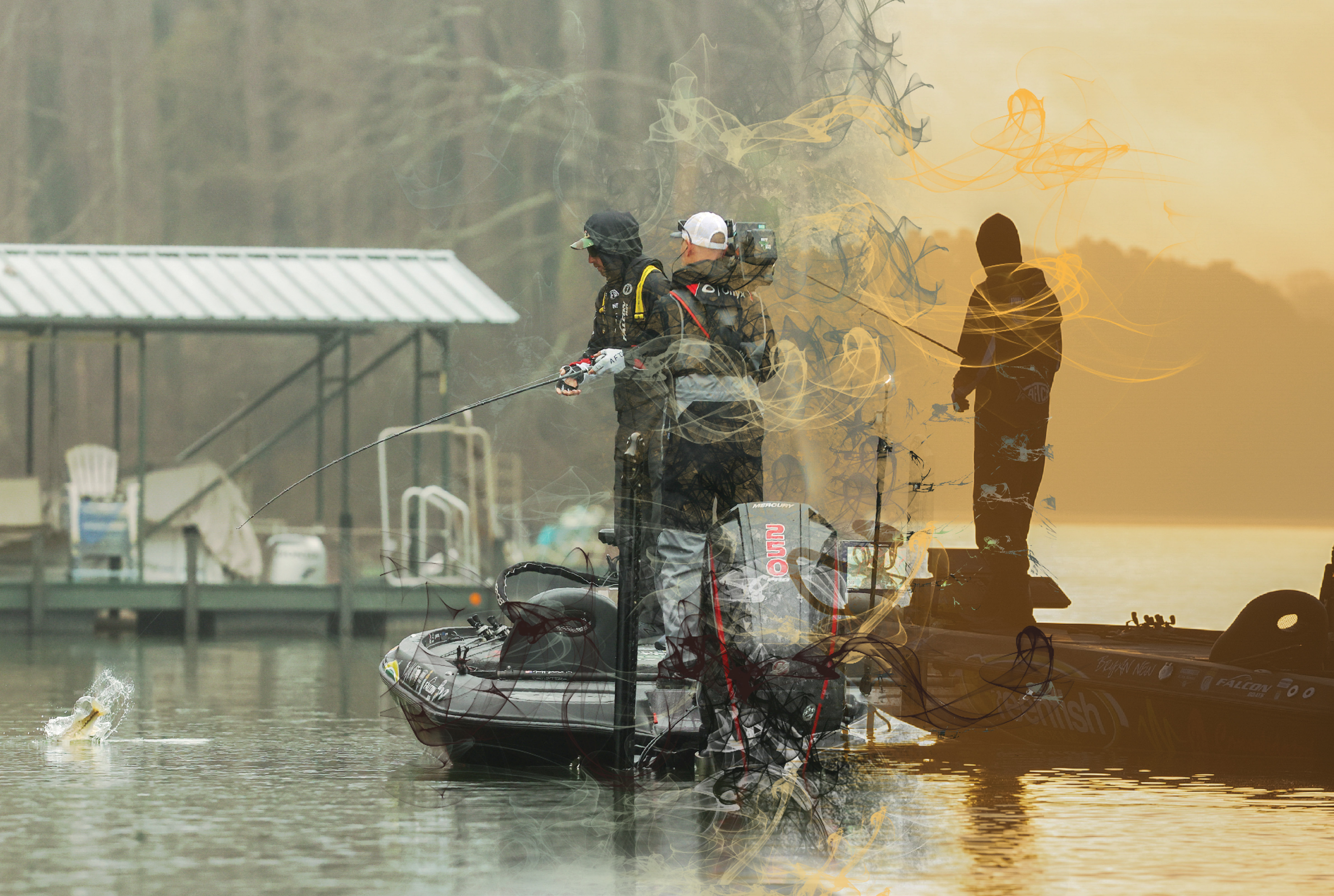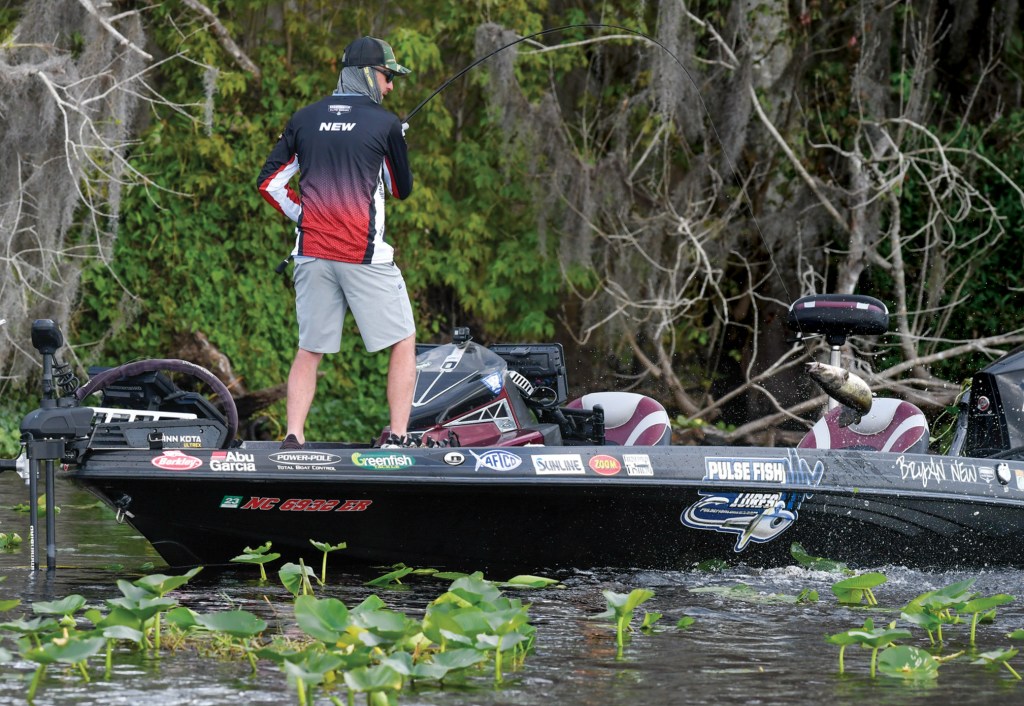
Bryan New has a long checklist of places to search for postspawn bass transitioning from spring spawning flats to deeper summer habitat, but his favorite is the area he found on Lake Toho just over a year ago that led him to victory in the 2020 Bassmaster Eastern Open. That win helped propel him to the Bassmaster Opens Angler of the Year title, which gave him entry into the 2021 Bassmaster Elite Series, leading to his win at the St. Johns River in the 2021 season-opener.
New, 32, laughs at the chain of events that Open win started, then turns serious as he discusses how he won that Open. It came during the postspawn season, a time many fishermen consider to be one of the most challenging to catch bass, the period when fish move from shallow spawning grounds to deeper summer structure.
“Anytime bass are in transition — moving from one type of habitat to another — can be difficult because it takes place over a number of weeks and might cover a fairly long distance,” explains New, who fished his first major tournament when he was 16. “You can get a lot of mixed signals that send you off in a totally wrong direction, or when you think you’re dialed in, everything might change overnight.
“That’s the way it is with moving fish. There are several fairly reliable places to look for postspawn transition bass, but the basic rule to remember is to begin your search close to a spawning area, looking for something different, preferably cover or a depth change. Then, gradually move out from there.”
New’s Toho win is a good example of this. On the lower end of Toho, on the way to the lock leading to Kissimmee, he found an area of scattered hydrilla clumps in water 8 feet deep. The top of the vegetation was 5 feet below the surface, and his best spot in it might have measured 30 by 40 yards square. Almost surprisingly, it was only a few long casts away from where the fish had just spawned.
“After spawning, I believe the two things a bass is most concerned with are feeding and finding a good hiding spot that allows it to ambush forage,” says New, “and that’s what the clumps of hydrilla offered. The forage itself was attracted to the hydrilla, so the bass didn’t need to move any further. On the second morning of the tournament, I caught a bass on nearly every cast for more than two hours.”
Thus, it’s easy to understand why underwater grassbeds rank high on New’s list of postspawn transition areas to look for when fishing any “grass” lake. It can be hydrilla, milfoil, moss, coontail or practically any other greenery growing relatively close to a spawning area, and New knows the pattern works from Champlain to Sam Rayburn to Okeechobee. Both squarebill and lipless crankbaits, as well as jerkbaits, run over the top of the vegetation, and a Texas-rigged Zoom Ol’ Monster worm are the Elite pro’s favorite lure choices.

On nongrass lakes, New’s checklist includes looking for the shad spawn; long, tapering points; ditch and channel intersections; and the first available cover or depth change. One or more of these options may pay off around different spawning areas on the same lake at the same time, since the spawn/postspawn may be in different phases. He nearly always starts fishing shallow, maybe doing something as simple as going down a shoreline throwing a small swimbait or a buzzbait. What New tries to avoid — and this is primarily because he’s a tournament fisherman — are well-known areas that other fishermen are also likely to visit. Future weather predictions, such as wind and/or rain, may also steer him to more protected water.
“Shad start spawning before bass have finished spawning, and this is one thing I always try to be aware of when I know the postspawn transition is taking place,” emphasizes New. “Shad spawn around rocks and docks, marina riprap, on gravel bars, even over vegetation and other shallow cover. This is when I like to use a swim jig or a small swimbait because shad will often follow it.”
Both threadfin and gizzard shad may begin spawning as early as March in many areas and continue periodically into August, a time frame that covers the bass spawning/postspawn season. As with bass, water temperatures ranging from 50 to as high as 70 degrees dictate much of this activity. Breeding and spawning takes place near the surface, and the eggs sink and adhere to the shallow rocks and other cover.
“If you see them following your lures, or if they’re rising and diving near the surface, you can guess they’re probably spawning, and bass will be nearby to feed on them,” he continues. “Early morning is usually the best time to take advantage of the shad spawn, but it will last for several days, and bass will be around them all that time.”
New also likes to fish long, tapering points in his search for transition bass, and they can be the very points forming the edges of a cove where bass have spawned. These points, however, need something to stop the fish and hold them there. Cover in the form of rocks, logs or stumps will do this because they also attract the forage bass are looking for, and they’re even more important if they’re the first such cover available. Crawfish may live on the point year-round if the habitat is agreeable, and current may also be a factor in how bass use a point.
“I believe current influences bass as much as anything,” notes New. “Even a lake that does not appear to have current will have more water movement than we realize, and the way that water moves dictates the way bass will set up. Wherever the bait goes, bass will go, and if a bass can find an ambush spot, that’s where it’s going to sit.”

Water movement may also dictate lure choice, and for New, the choices include crankbaits, jigs and Texas-rigged worms. If the current is noticeable, he’ll throw upstream and guide his lure down so that it moves as close to that ambush point as he can get it.
“It is difficult to say how long bass will stay on a point like this,” says New, “because fresh fish that have just spawned are coming to that same point while the earliest fish are moving out. It might be a few days or last a couple of weeks. I do know heavy fishing pressure will push bass further down the point into deeper water, but my advice is if you know the postspawn transition is just beginning, the first long point that’s nearby is definitely worth looking at. Start shallow and gradually work deeper with a crankbait or worm until you either find bass or decide they aren’t using that point.”
Depending on the configuration of a lake and its spawning areas, bass may stop their outward movement at the same places they stage when they’re moving in. Ditches, channels, small creeks and roadbeds, especially any intersections where one of these meets another, can be a postspawn hot spot. Each of these offers a depth change into deeper water as well as a type of travel corridor. Frequently, stumps, rocks, bushes and possibly even standing timber may be present along the edges.
“The majority of coves where bass spawn have some type of drainage running through them, a ditch, a channel, even a creek,” New explains, “and somewhere that little channel is going to intersect or flow into a larger channel. This intersection is fairly easy to identify with today’s electronics, and I promise you, it’s a place you don’t want to miss.
“When bass are utilizing channels and ditches in their movement, this intersection is probably the first place bass are going to stop on their way out into deeper water. On most intersections, there will be a hard spot, which is why there’s an intersection there, and it may well be the ‘sweet spot’ where the bass will hold.”
New fishes an intersection like this by positioning his boat in the larger channel so he can hit either point of the smaller ditch without moving. He’s sitting downcurrent of the intersection, casting upstream with a crankbait, swimbait, football jig or a big worm on a shaky head.
“I make my casts up on top and cover both points that way, and try to make each retrieve so the lure also comes off the lip where the point drops into the deeper water,” he explains. “Typically, the bass are right on the top of the break, or just off the edge, so I try to cover both of these on the same cast. Ideally, the depth will be between 8 and about 15 feet, but I have caught bass down to about 30 feet in junctions like this, particularly when I’m fishing where a creek channel empties into a main-river channel.”
Sometimes, fishing this postspawn transition almost boils down to its own form of junk fishing, says New, until you do locate fish. When you know the transition is occurring, start shallow and gradually work deeper. If you’ve never fished a particular lake before, start in a tributary creek or a large main-lake pocket — places where the majority of fish would spawn — and work out until you find them.
“Look for points that form the cove you’re fishing, or a channel leading out of that cove, but always keep the actual spawning flat in sight if you can,” concludes New, “because as soon as bass find what they’re looking for, like cover and a slight depth change, they’re probably going to stop.”
Originally appeared in Bassmaster Magazine 2022.





